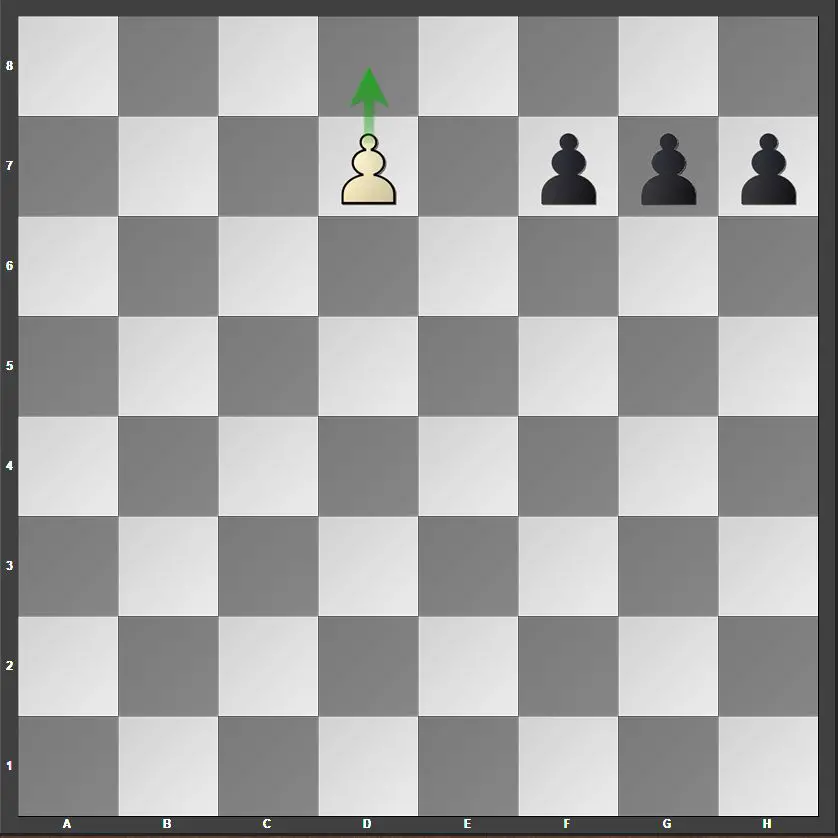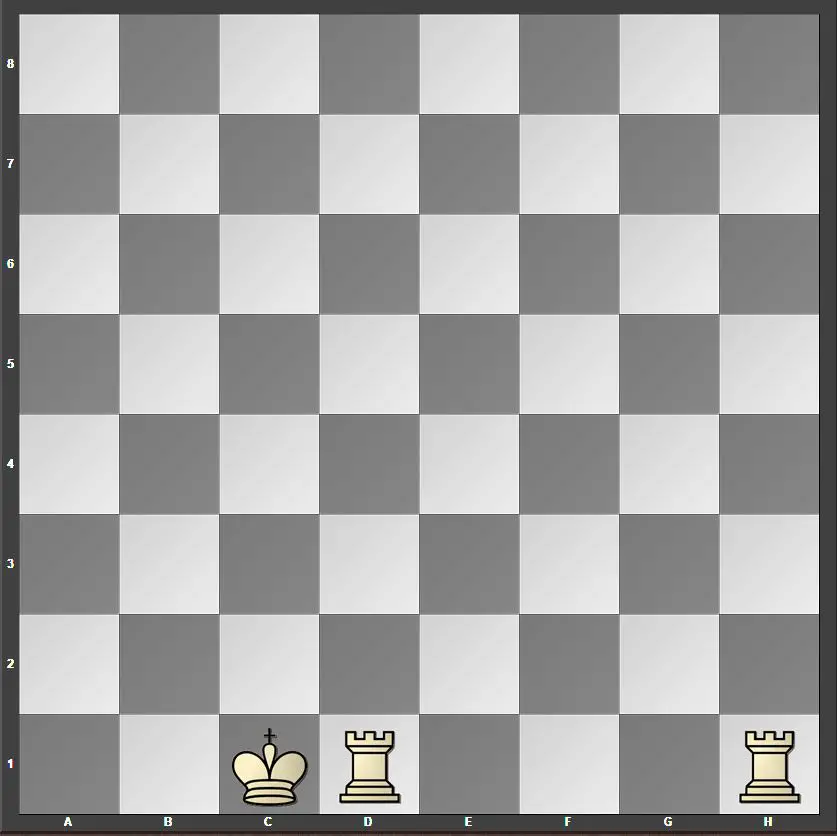If you want to expand your intellect, there is no better exercise than the game of chess. Maybe you have wanted to learn this game for a while now but you have very little idea about it. Maybe you want to teach your kids about chess, but don’t know where to start. So this post covers the ancient game of chess from the scratch. It will give you everything you need to know about the rules of the game.
The battle ground
Chess is not a silent board game with two people sitting across each other for hours without speaking anything. Chess is a war game. For the players who are involved in the game, it is an actual war where two opponents are constantly trying to outsmart one another. The battleground of chess is made of 64 squares with 32 light and 32 dark squares.

When you are sitting at the chessboard, make sure that the bottom right corner must be light Square (h1 square).

The numbers you see at the border of the chessboard are used to identify squares. For example:
- The green square on diagram-2 is on the ‘E’ column and the ‘4th’ rank. Therefore the square is called ‘e4’ square.
- The red square is on the ‘G’ column and ‘5th’ rank. Therefore it is called ‘g5’ square
The names of the pieces combined with squares create a unique identification for moves which we call notation in chess (link to the blog post). It is the language of chess that makes it easier to communicate the game of chess to others. We will get to it once we are done understanding the basics of chess. For now, do this exercise below to start identifying and getting the feel of the squares on the chessboard.
Exercise

There are six different types of pieces in chess: Pawn, Knight, Bishop, Rook, Queen and King. Let’s look at each one of them.
Pawn
The smallest one with the most courageous hearts, the pawns are known as the souls of chess. A pawn moves one square forward on each move. However, on its first move, every pawn has an additional possibility of moving two squares forward as shown in the image.


As shown in diagram-3,
- The white pawn standing on e5 square can move one square forward to e6.
- The black pawn standing on c6 square can move one square forward to c5
As shown in diagram-4, both pawns are in starting position
- The pawn on d2 can move to either d3 or d4 square
- The pawn on f7 can move to either f6 or f5 square
A pawn can capture an opponent’s piece which is placed one square diagonally. As shown in diagram-5,
- The white pawn on d4 can capture either e5 or c5 square, but it cannot capture the d5 pawn.
- The black pawns on e5 and c5 can capture the white pawn on d4 or they can chose to move forward one square as shown by red arrows.
- Also note that black’s pawn on d5 cannot move in this position.

There are two special pawn moves called ‘en passant’ and ‘pawn promotion’ that pawns can make which is covered in the later section of this post.
Knight
Knight is the only piece who can jump over other chess pieces. If you are a complete beginner, knight move would be the hardest to learn because it is slightly illogical. But it adds a lot of beauty to this game! We say that the knight moves ‘two steps forward and one step sideways in any direction‘.


Notice that the knight on White Square can only move to dark squares and vice versa. Also, note that the knight can note be blockaded because it can jump over pieces.
Bishop
The bishops move diagonally. There are two bishops in each army, light and dark squared bishops. The tragedy with the bishops is that they can never leave their colors. The light-squared bishop has to spend entire life in light squares and the same is the fate for the dark squared bishop, who is bound to dark squares.

Rook
The rooks move horizontally and vertically. Since they can move to all colors and in long range, they are stronger than bishops or knights.

Queen
Consider the queen as a combination of bishop and rook. Queen can move both diagonally and also in vertical and horizontal diagonals. Look at the number of squares a centralized queen covers. That is why it is the strongest and most valuable piece.

King
The king is lazy. It moves one square only in all directions. If the king comes under the radar of enemy piece movement, it is called ‘check’. The king cannot remain or move into check. As shown in diagram 11, the white king is in check by the black queen. The king must move to any of the green squares or the white bishop has to block the check by moving to e4.


Thus we have covered basics of all chess pieces and squares. However, there are a few special chess moves that you need to learn. Check them out below.
Special moves
The three special moves in chess are ‘en passant’, ‘pawn promotion’ and ‘castling’.
En-passant
Pawn can capture an opponent’s pawn that has just moved two squares bypassing the capture square of the enemy pawn. Check out the diagram below.



The black pawn is standing at e4. Now if white moves his pawn from d2 to d4, bypassing the d3 square on which black pawn could have captured him, the situation of the possible en-passant move is created. Here black can capture the d4 pawn by moving his pawn to d3. The final position will be as shown in the last diagram.
En-passant is possible only on the very next move after the pawn has moved two squares.
Pawn promotion
If by will of the god, your pawn reaches the last rank, it has the power to transform into any piece it wants (except for king and pawn itself of course).

The white pawn on d7 can move to d8 and can transform into either Queen, Rook, Bishop or Knight.
Castling
In chess one move is allowed when king and rook can jump across each-other. This is done to safeguard the king. It can be done on both sides as shown in the diagram below.



White can choose to castle either on king side or the queenside. The position after castling will be as shown in next two diagrams. Conditions of castle are:
- Castling is possible only if the king or the rook have not moved during the game.
- Castling is not possible when king is under a check.
- Castling is not possible when the path of the king comes under a check.
How the game begins and how it ends in chess?
The game always begins with the white’s moves. It can end in three results. Win, lost or a draw. When the king is in check and has no square to move outside of check, it is checkmate and the game is over. So the objective of the game is to checkmate the opponent king while avoiding yours from getting checkmated .
.
A draw results in various situations.
- When none of the army has enough forces to checkmate the opponent’s king.
- When one of the sides has no legal moves and the king is not in check, it is called ‘stalemate’ and the game is declared draw.
- Draw results when two sides repeat same moves for 3 times, it is called threefold repetition.
- A draw can also result by agreement between two players.
What is the time during which a player is thinking in chess called?
The time during which a player is thinking in chess called thinking time or move time. Each player has got his on time limit to play a game. If the player runs out of time, the opponent player will be declared as the winner of the game if he have a winning piece on the board.
The chess game starts with same time for both players. The classic games usually have 1 hr 30 min + 30 sec increment for each moves. Here the players get lot of time to play the move, where the blitz is limited to 3 to 10 min and bullet time may be as less as 1 min for both players
Conclusion
We have covered all the basics of chess and you are ready to go and play your first ever game of chess. If you are totally new, I would suggest that you first try moving individual pieces on the board to understand and grasp deeply the movement of each piece. Once you have enough feel for the game, you can start playing!
Also Read:

